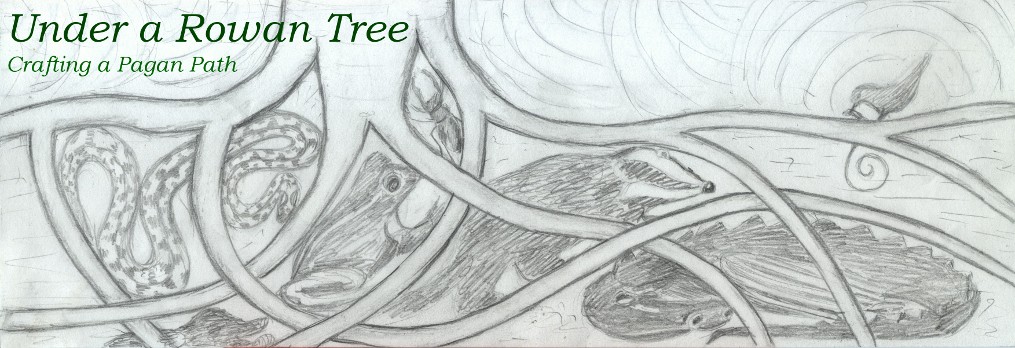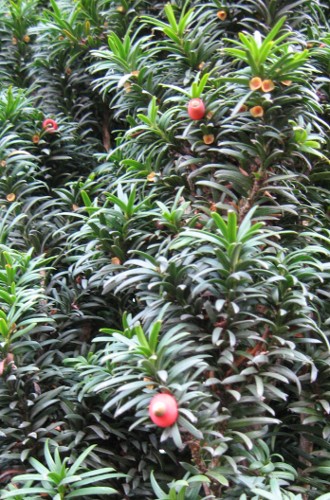Yew is now published on its own page – please use link above under ‘Tree Stories’.
My first encounters with yew as a witch did not go well. Yew did not wish to speak to me, and when I walked around a local graveyard, having visited the church first and enjoyed several faces peeking out from the stonework, I found a barrier. Yew did not wish me to go any further. I had never had trouble from a tree before, and when I tried to communicate with yew, on several occasions after that, it was closed to me.I will admit, I was fascinated. I started to read about yew, to understand its nature better and see if I could approach yew on its terms. The first thing I discovered was the incredible age to which yew trees can live. Until relatively recently it was thought that they lived to about eight hundred years or so. Then came a study of a tree in a churchyard in Tandridge, Surrey, in the 1980s. The foundations are Saxon, and it was found that they were built around the tree’s roots, indicating that the tree was fully grown over a thousand years ago. It is now thought to be around 2,500 years old, but that is only an estimate. The Fortingall yew is thought to be the oldest yew tree in Britain, with current estimates being 3-8,000 years old. However the hollow trunks that older trees develop make it impossible to count rings, so no one can be sure.
Yews can be very slow growing, around an inch in 25 years in normal circumstances, creating a very dense hardwood. However they will regenerate by producing shoots or aerial roots from almost any part of the trunk, including the inside if it becomes hollow. They can also send up suckers to start new trunks, or even layer themselves where a branch touches the ground. Therefore the tree that you see might not be the ‘original’. In fact fossil yews 1,000,000 years old are virtually the same as those growing now.
Every part of a yew tree is poisonous except for the red flesh of the arils, a type of hollow berry open at the end. Few animals can eat yew leaves, although deer are one exception. For some years hedge clippings were collected by drug companies to make the cancer treatment paclitaxel. However it has now been realised that the active part is a fungus that lives on the yew, which is able to be grown in a laboratory. Hopefully this will reduce the cost of production over time.
In the middle ages, yew was considered to make the best longbows. This unfortunately led to the chopping down of many yew trees across England – which is why most remaining ancient yew trees are the churchyard yews, of which it is estimated 500 are older than the church next to them. Further destruction to mature yews occurred when there was a law passed in 1492 to require four longbows to be imported with every tonne of goods, which led to the devastation of yew trees across Europe.
Yew is believed by many to be Yggdrasil, the World Tree in Northern traditions, as it fits the description of an evergreen ‘needle-ash’ best. It is generally associated with higher knowledge and wisdom, and divination. I had not personally associated it with tarot cards until I began thinking about a story inspired by yew. However the darker side of tarot seemed to be what was wanted, and I definitely had to back off to write this one down! Rather than try to contrive something with the cards, after creating the characters and having a rough outline of the story, I asked for a tarot reading to use. I seemed to take on the character of Amy as I shuffled, and the cards that were dealt were exactly as used in the story. The particular deck I used is ‘The Sacred Circle Tarot’ by Anna Franklin and Paul Mason.
I have mentioned before that I had been collecting sticks from each of the trees in the ogham. (A project put on hold after M was born.) I was interested that once I made a connection with yew, within a week I found a suitable sized yew stick lying on the pavement below an overgrown yew hedge. However yew is sometimes used to make a whole ogham set, because its exceptional durability makes it a very potent wood for magical purposes; yew wands are also good for this reason.
To me the yew is not a tree of death, but of reincarnation and eternal life. Yews have been cut down when it was believed they were dying, yet that was only the end of their first incarnation.

